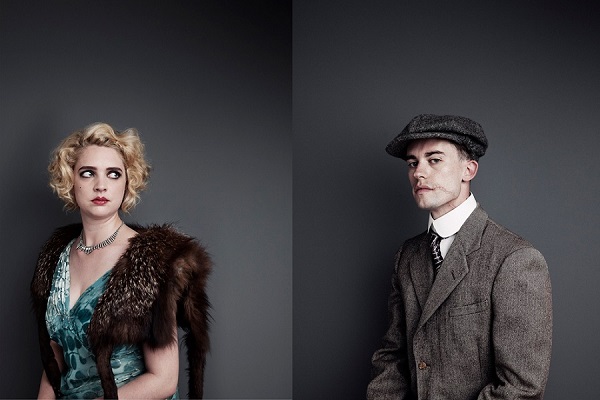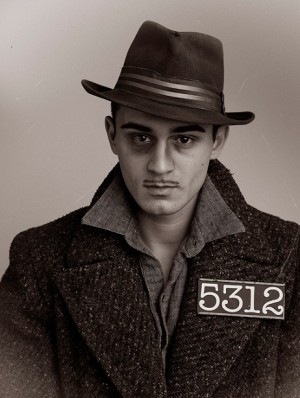The Price of Crime: Photographer Nick Dolding’s “Wanted” Captures the Emotion — and Enmity – of a Life of Crime
Their crimes are horrendous, their punishments equally so. Theft, embezzlement, murder, and a host of other offenses utterly deplorable to society are some of the things they are guilty of. Their sentences: years of imprisonment, forced labor in work camp chain gangs, and in some cases, execution.
Dark as such a topic is, crime — and punishment — is the theme of London-based photographer Nick Dolding’s project Wanted.
“I’d always been interested in the mafia and crime,” explains Dolding. “It’s gone down brilliantly.”
Though the specific characters featured — men and women bedecked in 1920s garb and posed in such a way there’s little doubt what the viewer sees is the police “mug shot” of the criminals in question — may be fictional, they boast a realism that is nothing short of squirm-inducing.
“We wanted to try and make it a bit more three-dimensional,” says Dolding. “We even took people’s fingerprints and badges to push that realism. I really wanted to push the feel of it.”
The mug shots the characters are posed for may seem different than the straight-on angle one usually sees in the crime section of newspapers today, but it harkens back to an era when even booking photos of accused criminals had a certain glamor about them. There are no orange or striped jumpsuits on these criminals, but expensive suits and fancy dresses that today would be the instant hallmark of high society. The upmarket attire would almost be enough to make one forget these people are criminals — but the booking number included in each image betrays this notion.
What’s interesting about the photos is what they subconsciously suggest to the viewer. Simple backgrounds put the focus squarely on the individuals face, and though they may be dressed in what modern viewers would consider their Sunday best, they still elicit disdain thanks to subtle effects such as visible scars, unkempt hair, and dour expressions that betray how they might be feeling. They also suggest what crimes they might have committed: an elderly man in a pinstripe suit suggests Wall Street embezzlement, while two heavyset men in round faces just scream “mafia muscle” or hired hooligan. A blonde woman with an elegant fur shawl suggests thievery of some type. That ranks as perhaps the most stunning of the collection, partially because of its unusualness of a female suspect from an era when women facing prosecution was somewhat of a rarity, and partially because the manner of the model’s elegant — at least by today’s standards — dress makes it appear it could be a shot for a fashion campaign. Likewise, a pair of shots of a darker-skinned gentleman in a wool jacket with a bandage around his head is particularly arresting, though unlike the other images one has difficulty guessing what sort of crimes he may be accused of; perhaps it is a commentary on prejudice and social injustice. Regardless of the background, there is real emotion in his eyes, which appear to be nothing short of remorseful.

Two mug shots from photographer Nick Dolding’s “Wanted” series. Photo Courtesy of: Nick Dolding.
The mug shot was invented by Allan Pinkerton, a Scottish-American detective who lived during the 19th century, and became popular during the questioning of suspects immediately following the assassination of US President Abraham Lincoln in 1865. The multiple images in Wanted are suggestive of a “rogues gallery,” a police collection of pictures or photographs of criminals and suspects kept for identification purposes. Suspects are shown both front-on and in profile, adding to the overall realism of the project in such a way that one can almost shut their eyes and see a police officer shouting “turn!” to the assemblage of ne’er-do-wells.
But, of course, the person calling the shots wasn’t an officer of the law, but Dolding himself. The shoot came together over a hectic period of two days that involved no less than an art director, two prosthetic makeup artists, a hairdresser, two assistants and 11 models (seven of whom were shot on the first day) who assembled at Dolding’s studio. Such a large number of people may seem hectic, but Dolding says everything came together surprisingly well.
“It was just a good shoot day,” he says. “The team was brilliant.”
However, it was not without its hiccups. Just a week before the shoot was to take place, a prosthetic makeup artist dropped out, causing Dolding to scramble for a replacement.
“On the one hand, it was tough because I got screwed, but it all worked out in the end,” he explains.
The project has received varied press attention. Online media have covered it, as has La Repubblica, one of Italy’s largest newspapers. But for all of its coverage, it is unknown if the Camorra, Cosa Nostra or ‘Ndrangheta (Italy’s most prominent mafia organizations) have commented.
That’s probably a good thing — not just for Dolding, but for viewers who find the characters equally fascinating and reprehensible, too.

Featured image: A mug shot from photographer Nick Dolding’s “Wanted” series. Photo Courtesy of: Nick Dolding.

